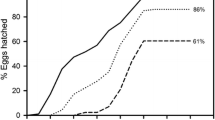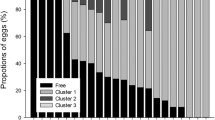Abstract
The biology of resting eggs of monogonont rotifers is reviewed, covering literature published since the last major review by Gilbert (1974). The topics examined include resting egg production, morphology and species specificity, hatching, and evolutionary significance.
Four major determinants of resting egg production are identified: mictic female production, male activity and fertility, female susceptibility to fertilization, and fertilized female fecundity. Recent work in these four areas is discussed as well as resting egg production in natural populations. Resting egg morphology, particularly shell structure and internal organization, is compared among species. Recent reports on the control of resting egg hatching in the laboratory are examined and the importance of temperature, light, diet, and salinity is reviewed. Two hatching patterns are contrasted, the first where eggs hatch at regular intervals over extended periods and the second where hatching is synchronized to some environmental cue. A latent period after resting egg formation, during which no hatching occurs, is defined for several species. The adaptive features of resting eggs are outlined including their contribution to genetic variability through recombination, their provision for environmental escape by dormancy, and their colonizing function resulting from their ease of dispersal. The type of cue utilized to initiate mictic female production as well as the pattern of resting egg hatching is related to environmental predictability.
Similar content being viewed by others
References
Birky, C. W. & Gilbert, J. J., 1971. Parthenogenesis in rotifers: The control of sexual and asexual reproduction. Am. Zool. 11: 245–266.
Blanchot, J. & Pourriot, R., 1982. Influence de trois facteurs de l'environment, lumière, temperature et salinité, sur l'eclosion des oeufs de durée d'un clone de Brachionus plicatilis (O.F. Müller) (Rotifère). C. r. Acad. Sci., Paris 295: 243–246.
Bogoslovsky, A. S., 1929. Observations on rotifer ecology. I. Some data on the ecology of Conochilus volvox Ehr., C. unicornis R. and Lacinularia socialis and observations on their resting eggs. Bull. Stat. biol. Bolchevo 3: 7–25.
Bogoslovsky, A. S., 1963. Materials to the study of the resting eggs of rotifers. Communication I. Byull. Mosk. Obshch. Ispyt. Prir. 68: 50–67.
Bogoslovsky, A. S., 1967. Materials to the study of the resting eggs of rotifers. Communication 2. Byull. Mosk. Obshch. Ispyt. Prir. 72: 46–67.
Bogoslovsky, A. S., 1969. Materials to the study of the resting eggs of rotifers. Communication 3. Byull Mosk. Obshch. Ispyt. Prir. 74: 60–79.
Clément, P., Pourriot, R. & Rougier, C., 1976. Les facteurs exogenes et endogenes qui controlent l'apparition des males chez les Rotifères. Bull. Soc. zool. Fr. 101: 86–95.
Clément, P. & Pourriot, R., 1977. Cytoplasmic and chromosomal inheritance of the mictic reaction in a parthenogenetic clone of Notommata copeus. Arch. Hydrobiol. Beih. 8: 205–206.
Clément, P. & Pourriot, R., 1979. Influence de l'age des grandparents sur l'apparition des males chez le Rotifère Notommata copeus Ehr. Int. J. Invert. Rep. 1: 89–98.
Clément, P. & Pourriot, R., 1980. About a transmissible influence through several generations in a clone of the rotifer Notommata copeus. Hydrobiologia 73: 27–31.
Cohen, D., 1966. Optimizing reproduction in a randomly varying environment. J. theor. Biol. 12: 119–129.
Cohen, D., 1967. Optimizing reproduction in a randomly varying environment when a correlation may exist between conditions at the time a choice has to be made and the subsequent outcome. J. theor. Biol. 16: 1–14.
Cohen, D., 1968. A general model of optimal reproduction in a randomly varying environment. J. Ecol. 56: 219–228.
Elgmork, K., 1980. Evolutionary aspects of diapause in freshwater copepods. In: Kerfoot, W. C. (Ed.), Evolution and Ecology of Zooplankton Communities. University Press of New England, Hanover, N.H.: 411–417.
Gilbert, J. J., 1963. Contact chemoreception, mating behavior, and sexual isolation in the rotifer genus Brachionus. J. exp. Biol. 40: 625–641.
Gilbert, J. J., 1974. Dormancy in Rotifers. Trans. am. microsc. Soc. 93: 490–513.
Gilbert, J. J., 1977. Mictic female production in monogonont rotifers. Arch. Hydrobiol. Beih. 8: 142–155.
Gilbert, J. J., 1980a. Some effects of diet on the biology of the Rotifers Asplanchna and Brachionus. In: Smith, D. C. & Tiffon, Y. (Eds.), Nutrition in the Lower Metazoa. Perg. Per., Oxford: 57–71.
Gilbert, J. J., 1980b. Female polymorphism and sexual reproduction in the Rotifer Asplanchna: evolution of their relationship and control by dietary alpha-tocopherol. Am. Nat. 116: 409–431.
Gilbert, J. J. & Wurdak, E. S., 1978. Species-specific morphology of resting eggs in the Rotifer Asplanchna. Trans. am. microsc. Soc. 97: 330–339.
Halbach, U. & Halbach-Keup, G., 1974. Quantitative Beziehungen zwischen Phytoplankton and der Populationsdynamik des Rotators Brachionus calyciflorus (Pallas). Befunde aus Laboratoriumexperimenten und Freilanduntersuchungen. Arch. Hydrobiol. 73: 273–309.
Hino, A. & Hirano, R., 1977. Ecological studies on the mechanism of bisexual reproduction in the rotifer Brachionus plicatilis-11. Effects of cumulative parthenogenetic generation. Bull. jap. Soc. scient. Fish. 43: 1147–1155.
Ito, T., 1958. Studies on the ‘Mizukawari’ in eel-culture ponds. 10. The density of dormant eggs of rotifer on bottom deposits in eel-culture ponds. Rep. Fac. Fish. Prefect. Univ. Mie 3: 170–177.
Ito, T., 1960. On the culture of the mixohaline Rotifer Brachionus plicatilis O. F. Müller in the sea water. Rep. Fac. Fish. Prefect. Univ. Mie 3: 708–740.
King, C. E., 1967. Food, age, and the dynamics of a laboratory population of rotifers. Ecology 48: 111–128.
King, C. E., 1970. Comparative survivorship and fecundity of mictic and amictic female rotifers. Physiol. Zool. 43: 206–212.
King, C.E., 1977. Genetics of reproduction, variation, and adaptation in rotifers. Arch. Hydrobiol. Beih. 8: 187–201.
King, C. E., 1980. The genetic structure of zooplankton populations. In: Kerfoot, W. C. (Ed.), Evolution and Ecology of Zooplankton Communities. University Press of New England, Hanover, N.H.: 315–328.
King, C. E. & Snell, T. W., 1977. Sexual recombination in rotifers. Heredity 39: 357–360.
Lubzens, E., 1981. Rotifer resting eggs and their application to marine aquaculture. Spec. Publ. eur. Maricult. Soc. 6: 163–180.
Lubzens, E., Fishler, R. & Berdugo-White, V., 1980. Induction of sexual reproduction and resting egg production in Brachionus plicatilis reared in sea water. Hydrobiologia 73: 55–58.
Manning, J. T. & Jenkins, J., 1980. The ‘balance’ argument and the evolution of sex. J. theor. Biol. 86: 593–601.
Maynard-Smith, J., 1978. The Evolution of Sex. Cambridge University Press, Cambridge.
Muenchow, G., 1978. A note on the timing of sex in asexual/ sexual organisms. Am. Nat. 112: 774–779.
Nipkow, F., 1961. Die Rädertiere im Plankton des Zürichsees and ihre Entwicklungsphasen. Schweiz. Z. Hydrol. 23: 398–461.
Piavaux, A. & Magis, N., 1970. Données complementaires sur la localisation de la chitine dans les enveloppes des oeufs de Rotifères. Ann. Soc. r. zool. Belg. 100: 49–59.
Pourriot, R., 1967. Males et oeufs durables de quelques Rotifères. Bull. Soc. zool. Fr. 92: 185–192.
Pourriot, R., 1973. Recherches sur la biologie des Rotifères. 3. Fecondité et durée de vie comparée chez les femelles mictiques, fecondées et non fecondées, de quelques espèces. Ann. Limnol. 9: 241–258.
Pourriot, R. & Rougier, C., 1976. Influence de Page des parents sur la production de femelles mictiques chez Brachionus calyciflorus (Pallas) et B. rubens Ehr. (Rotifères). C. r. Acad. Sci. Paris 283: 1497–1500.
Pourriot, R. & Clément, P., 1977. Comparison of the control of mixis in three clones of Notommata copeus. Arch. Hydrobiol. Beih. 8: 174–177.
Pourriot, R. & Rougier, C., 1979. Influences conjugées du groupement et de la qualité de la nourriture sur la reproduction de Brachionus plicatilis O. F. Müller (Rotifère). Neth. J. Zool. 29: 242–264.
Pourriot, R. & Clément, P., 1981. Action de facteurs externes sur la reproduction et le cycle reproducteur des Rotifères. Acta. Oecol., Oecol. Gen. 2: 135–151.
Pourriot, R., Rougier, C. & Benest, D., 1981. Role de la lumiere et de la temperature dans l'éclosion des oeufs de duree de Brachionus rubens Ehr. (Rotifère). Neth. J. Zool. 31: 637–649.
Pourriot, R., Benest, D. & Rougier, C., in press. Effet de la temperature sur l'éclosion d'oeufs de durée provenant de populations naturelles de Brachionidae (Rotifères). Bull. Soc. zool. Fr. 108: 59–66.
Pourriot, R., Benest, D. & Rougier, C., in press. Eclosions des oeufs de duree de Brachionus calyciflorus (Pallas). Comparaison de deux clones. Vie et Milieu.
Rougier, C. & Pourriot, R., 1977. Aging and control of reproduction in Brachionus calyciflorus (Pallas) (Rotifère). Exp. Gerontol. 12: 137–151.
Ruttner-Kolisko, A., 1946. Ueber das Auftreten unbefruchteter ‘Dauereier’ bei Keratella quadrata. Öst. zool. Z. 1: 179–191.
Ruttner-Kolisko, A., 1974. Plankton Rotifers. Biology and Taxonomy. Binnengewässer 26: 146 pp.
Shull, A. F., 1913. Inheritance in Hydatina senta. 1. Viability of the resting eggs and the sex ratio. J. exp. Zool. 15: 49–89.
Snell, T. W. & Bieberich, C. J., in preparation. Factors modulating mictic female production in the rotifer Brachionus plicatilis.
Snell, T. W. & Hawkinson, C. A., in press. Behavioral reproductive isolation among populations of the rotifer Brachionus plicatilis. Evolution.
Snell, T. W., Burke, B. L. & Messur, S. D., in press. Size and distribution of resting eggs in a natural population of Brachionus plicatilis. Gulf Research Reports.
Snell, T. W. & Bieberich, C. J., in prep. Factors influencing resting egg hatching in Brachionus plicatilis.
Templetion, A. R. & Levin, D. A., 1979. Evolutionary consequences of seed pools. Am. Nat., 114: 232–249.
Williams, G. C., 1975. Sex and Evolution. Princeton University Press, Princeton.
Wurdak, E. S., Gilbert, J. J. & Jagels, R., 1978. Fine structure of the resting eggs of the rotifers Brachionus calyciflorus and Asplanchna sieboldi. Trans. Am. microsc. Soc. 97: 49–72.
Author information
Authors and Affiliations
Rights and permissions
About this article
Cite this article
Pourriot, R., Snell, T.W. Resting eggs in rotifers. Hydrobiologia 104, 213–224 (1983). https://doi.org/10.1007/BF00045970
Issue Date:
DOI: https://doi.org/10.1007/BF00045970




